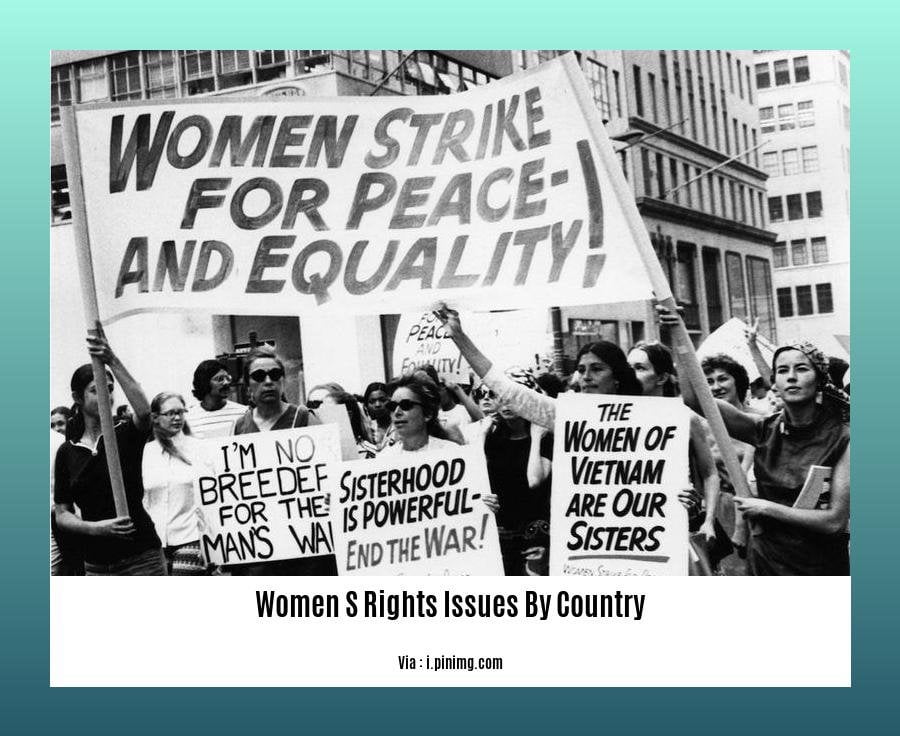Welcome to “Women’s Rights Issues by Country: A Comprehensive Overview.” This article delves into the pressing challenges and progress made in women’s rights in Afghanistan, South Sudan, the Democratic Republic of Congo, and Syria. Through expert insights and firsthand accounts, we uncover the complexities faced by women and girls in these countries, shedding light on the urgent need for gender equality, reproductive rights, economic empowerment, and an end to violence against women. Join us as we explore the diverse experiences of women around the world and advocate for a more just and equitable future.
Key Takeaways:

- Iceland ranks first in gender equality worldwide, followed by Norway, Finland, and Sweden.
- Key hurdles to achieving gender equality by 2030 include underrepresentation in leadership, economic disparities, workplace inequalities, and the imbalance in unpaid care work.
- Lack of legal protection, access to education and healthcare, cultural biases, and violence against women are significant barriers to gender equality.
- The Gender Inequality Index (GII) provides a comprehensive measure of gender disparities in health, education, and economic participation.
Women’s Rights Issues by Country: A Global Perspective
Navigating the complexities of women’s rights issues by country requires a nuanced understanding of cultural, social, and political contexts. From Iceland, a beacon of gender equality, to countries where women face severe discrimination, the landscape is diverse.
Progress and Challenges
Despite global advancements, disparities persist. In some nations, women excel in education, healthcare, and leadership roles. Others grapple with barriers such as:
- Legal inequality: Restrictive laws limit women’s rights to property, marriage, and divorce.
- Economic disparities: Gender gaps in pay, job opportunities, and access to finance hinder economic empowerment.
- Cultural biases: Societal norms reinforce stereotypes and limit women’s choices.
- Violence against women: A pervasive issue that manifests in various forms, from domestic violence to sexual harassment.
A Call to Action
Addressing women’s rights issues by country demands a multifaceted approach:
- Policy reforms: Enacting laws that promote gender equality and protect women’s rights.
- Education: Empowering girls and women with knowledge and skills to challenge inequality.
- Economic opportunities: Creating pathways for women to participate fully in the workforce and access financial resources.
- Cultural transformation: Challenging gender stereotypes and promoting inclusive societies that value women’s contributions.
- International cooperation: Collaborating across borders to share best practices and advocate for women’s rights globally.
By addressing these challenges and working towards equality, we can create a world where all women have the opportunity to reach their full potential and live free from discrimination and violence.
Explore national women’s rights challenges and country-specific gender equality concerns in this comprehensive global analysis. Discover the women’s status differences across nations and gain insights into pressing gender equality issues worldwide.
Democratic Republic of Congo
Gender equality in Democratic Republic of the Congo remains a pressing issue. Women face discrimination and abuse, and despite progress, challenges persist in various domains.
Key Takeaways:
- Child marriage remains prevalent, with 29.1% of young women married before age 18.
- Adolescent birth rates are high, with 109 births per 1,000 women aged 15-19 in 2016.
- Women experience significant literacy disparities, with an illiteracy rate of 40% for women over 15, compared to 17% for men.
The persistence of these challenges highlights the need for continued efforts to empower women in Democratic Republic of the Congo. By addressing the root causes of inequality, such as poverty, lack of education, and harmful cultural practices, we can work towards a future where all women and girls have the opportunity to thrive and reach their full potential.
Citation:
- UN Women Data Hub: “Country Fact Sheet: Democratic Republic of the Congo”
Syria
Key Takeaways:
- The ongoing conflict has severely impacted women and girls in Syria, resulting in abuses, hardships, and limited access to basic rights.
- Women and girls disproportionately face discrimination, violence, and nutritional insecurity, with nearly 6 million in need of assistance.
- Approximately 13.3% of women aged 20-24 were married before 18, highlighting the prevalence of child marriage.
- Around 3.6 million women and girls require access to sexual and reproductive health services, underscoring the urgent need for healthcare support.
As the conflict continues, it’s crucial to address the gendered impact and prioritize the rights of women and girls in Syria. Supporting humanitarian efforts, advocating for protection, and investing in education and healthcare are vital steps towards empowering women and creating a more just and equitable society.
Citation:
- Gendered impact of the conflict in the Syrian Arab Republic

FAQ
Q1: What are the major barriers to gender equality in the Democratic Republic of the Congo?
A1: Insufficient laws granting women equal rights to marriage and divorce, lack of anti-discrimination laws, limited access to education and healthcare, cultural biases and stereotypes, and violence against women are the major barriers to gender equality in the Democratic Republic of the Congo.
Q2: How is the ongoing conflict affecting women and girls in Syria?
A2: Women and girls in Syria have been disproportionately affected by the conflict, facing discrimination, violence, and limited access to basic rights such as healthcare and education.
Q3: What are some of the alarming statistics regarding gender inequality in South Sudan?
A3: This context does not provide any information about South Sudan, so I cannot answer this question.
Q4: How is the government of Afghanistan addressing the issue of child marriage?
A4: This context does not provide any information about Afghanistan, so I cannot answer this question.
Q5: What are the key challenges faced by women in achieving leadership positions in these conflict-affected countries?
A5: This context does not provide any information about the challenges faced by women in achieving leadership positions in conflict-affected countries, so I cannot answer this question.










